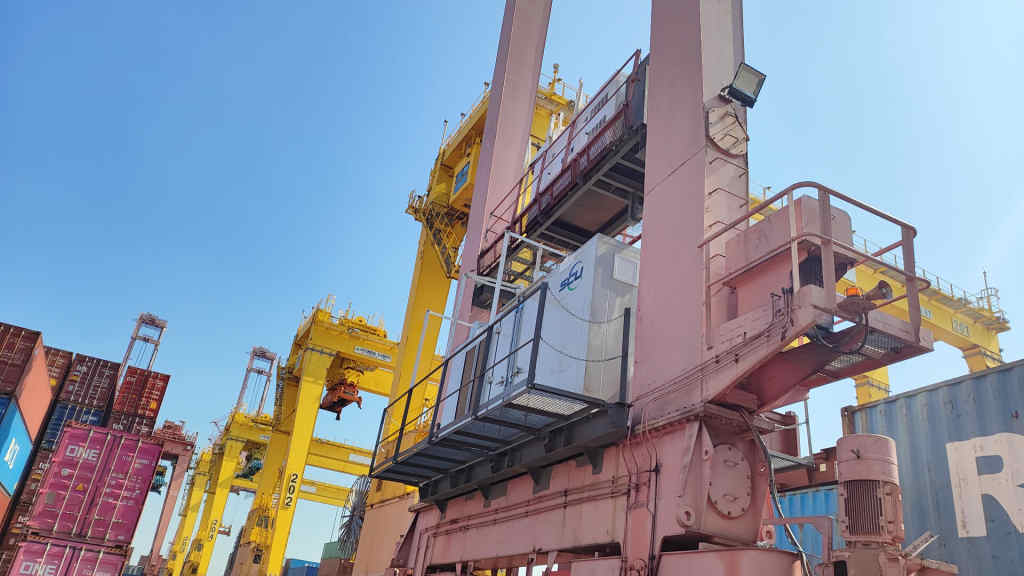Ports and container terminals are important hubs for global trade in goods. Port container handling is mainly done using Rubber-Tired Gantry Cranes (RTGs). Energy costs, CO2 emissions and noise from port equipment are all issues that require energy storage solutions to reduce energy demand.
In current operation, the RTG’s power source is mainly diesel generator sets. The main problem with using a conventional diesel genset to power an RTG is that the genset is overpowered for most of the operating time, resulting in very high fuel consumption and emissions. In addition, large-capacity generator sets bring additional challenges, such as high noise levels and maintenance work.
SCU joined hands with a diesel generator manufacturer to provide RTG diesel-electric hybrid solutions for Thai ports. This solution closely integrates SCU’s energy storage container with shore power to provide efficient and sustainable power support for the port’s RTG, becoming a major initiative in port electrification.

RTG Energy Storage System Solution:
Based on customer requirements, we designed two 20ft energy storage containers.
There are three modes in total: charging mode, discharging mode and energy recovery mode.
Lithium-ion batteries are used as energy storage system. It is charged on the one hand via shore power and, on the other hand, by recovering and reusing the energy generated when braking and lowering the load.
- When the RTG needs to rise, the energy storage container quickly supplies electric energy, achieving efficient energy storage and power supply.
- During the process of RTG falling, the system cleverly absorbs excess electric energy and feeds it back to the energy storage container, realizing energy feedback and reuse.
This intelligent design not only improves the efficiency of electric energy utilization but also greatly reduces the dependence on traditional diesel generators, thus promoting the sustainable development of port electrification.

Shore power-energy storage integration
The integrated shore power energy storage system is an inevitable choice. When electricity prices are low, the electricity is stored in the battery, and when shore power is needed, the electricity is transmitted. This plays a role in “peak shaving and valley filling” for the power grid and also reduces the direct cost of using shore power.
In addition to reducing the cost of using shore power, the integrated shore power energy storage system also helps improve the power quality and safe operation of the port power grid. Mechanical equipment such as shipping cranes and gantry cranes used in ports are all subject to impact loads. Power grid voltage fluctuations and flicker phenomena occur from time to time. Power quality issues are potential sources of danger for the safe and reliable use of electricity in ports. The energy storage system can smooth out peak loads such as shore power, as well as voltage fluctuations and flickers, and directly filter grid noise.
Advantages of port energy storage system:
- Improve power quality
The load characteristics of port equipment change frequently, and the power quality of the power supply network is difficult to guarantee. Currently, it is commonly used to increase the capacity of the power supply system to solve such problems, but this method has high investment costs and will cause a waste of resources. The main power load of the port is concentrated on high-power, long-lasting equipment. When these high-power equipment is working, the lifting mechanism of the lifting mechanism generates a large amount of electric energy during the lowering process of the cargo. Energy storage technology will make the heavy-load equipment Dynamic energy recovery can achieve the purpose of energy saving and improving power quality and realize the effect of recycling and reuse.
- Peak shaving and valley filling
Port electricity is billed based on the peak-valley price difference. During the day, the peak price is basically used, and most load operations occur during this period. At night, the price is mostly low, and the load operation time is relatively short. If the peak-valley electricity price difference can be fully utilized, it will definitely bring considerable benefits to the port. Ports use energy storage technology to transfer peak and valley power, which can control load power in the port’s internal power supply network without affecting the stability of the upper-level power supply network. At the same time, it can reduce the port’s installed capacity and save a lot of costs.
- Power failure protection
If the electric energy is stored smoothly on the power consumption side and through simple and reliable control technology, the output of high-quality electric energy can be ensured. The energy storage system can be used as a backup power supply to provide reliable protection for the port power supply network when there is an insufficient power supply or power grid failure.
SCU provides innovative power solutions: RTG energy storage system for Thai ports through its excellent technical strength and rich experience in the energy storage field. This successful cooperation not only re-verifies SCU’s technical strength but also provides a more feasible solution for the future of port electrification.
This cooperative program is in line with the general trend of port electrification around the world. More and more ports are accelerating electrification to achieve more environmentally friendly, efficient and sustainable development. By reducing carbon emissions, improving energy efficiency and promoting the integration of renewable energy, SCU is committed to building a greener and more sustainable future. We firmly believe that through the promotion of new energy technology, we can not only provide efficient solutions for port operations but also make positive contributions to global environmental protection.
